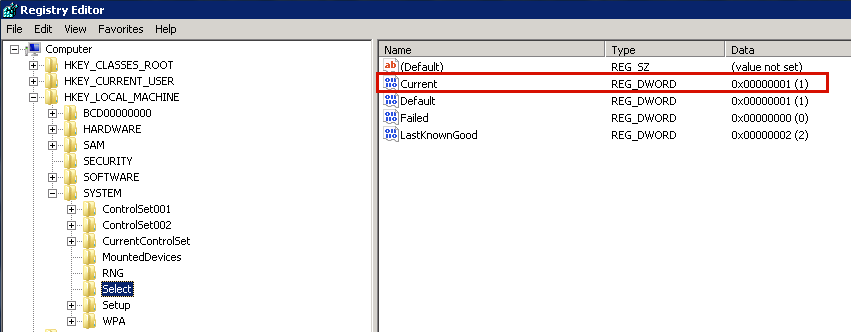Windows failed to start after Arcserve UDP Agent (Windows) is installed
If Windows failed to start with the following error after Arcserve UDP Agent (Windows) has recently been installed, it can be caused by a Windows internal failure.
- File: ARCFlashVolDrv.sys
- Status: 0xc0000098
- Info: Windows failed to load because a required file is missing, or corrupt.
The probable causes for this problem are:
- User temporary folder is not writable
- Insufficient privilege
- Windows update database corrupted
Important! This procedure contains information about modifying the registry. Before you modify the registry, make sure to create a backup of the registry and ensure that you understand how to restore the registry if a problem occurs. For more information about how to back up, restore, and edit the registry, see the relevant Microsoft Knowledge Base articles.
To resolve this problem, perform the following steps to uninstall the driver:
- Use the Create Boot Kit for Bare Metal Recovery utility to create the BMR ISO image if you do not already have it. For more information, see How to Create a Boot Kit in the online help.
- Click Run from the Utilities menu.
- Enter "regedit" in the Run dialog and click OK to open Registry Editor.
- Select HKEY_LOCAL_MACHINE and click "Load Hive..." from the File menu in the Registry Editor.
- Locate SYSTEM file under the %systemroot%\system32\config directory on your system and click open.
- Enter a name for the hive to be loaded.
- From the Registry Editor, check the "Current" entry under "HKEY_LOCAL_MACHINE\SYSTEM\Select".

- Depending on the Current value that is displayed, delete the corresponding entries under the new hive that was just loaded:
- For example:
- If the Current Value is 1, then delete the following entries:
- If the Current Value is 2, then delete the following entries:
HKEY_LOCAL_MACHINE\%your_hive_name%\ControlSet001\Services\ARCFlashVolDrv
HKEY_LOCAL_MACHINE\%your_hive_name%\ControlSet001\Services\Eventlog\System\ARCFlashVolDrv
HKEY_LOCAL_MACHINE\%your_hive_name%\ControlSet002\Services\ARCFlashVolDrv
HKEY_LOCAL_MACHINE\%your_hive_name%\ControlSet002\Services\Eventlog\System\ARCFlashVolDrv
- Depending on the Current value that is displayed, delete the corresponding value "ARCFlashVolDrv" for the following registry keys:
- For example:
- If the Current Value is 1, then delete the following entries:
- If the Current Value is 2, then delete the following entries:
Important! The "LowerFilters" registry key may also contain other Windows driver names. Be sure to delete only the "ARCFlashVolDrv" value from the list. Do not delete the entire registry key or any other driver names from within the key.
HKEY_LOCAL_MACHINE\%your_hive_name%\ControlSet001\Control\Class\{533C5B84-EC70-11D2-9505-00C04F79DEAF}\LowerFilters
HKEY_LOCAL_MACHINE\%your_hive_name%\ControlSet001\Control\Class\{71A27CDD-812A-11D0-BEC7-08002BE2092F}\LowerFilters
HKEY_LOCAL_MACHINE\%your_hive_name%\ControlSet002\Control\Class\{533C5B84-EC70-11D2-9505-00C04F79DEAF}\LowerFilters
HKEY_LOCAL_MACHINE\%your_hive_name%\ControlSet002\Control\Class\{71A27CDD-812A-11D0-BEC7-08002BE2092F}\LowerFilters
- Click "Unload Hive..." from the File menu in the Registry Editor.
- Perform the following troubleshooting steps:
- Verify that the user account has administrator privileges on this machine.
- Verify that the user account has write permissions on the following temp folders:
- %windir%/temp
- %temp%
- For Microsoft Windows Vista and Microsoft Windows 2008 and later, download and run the Microsoft System Update Readiness Tool. This tool helps to fix any inconsistencies or corruption in the installed updates and system files.
- Determine if there are any pending Windows updates or reboots and take the necessary action. Perform one of the following tasks to show Windows Update related information for the computer:
- Click Start, All Programs, Windows Update.
- Access Update.
- If there are problems installing several Windows Updates, then examine why the updates cannot be installed on this computer before proceeding to the next step.
- Reinstall the ARCFlashVolDrv driver by running "ARCFlashVolDrvINSTALL.exe –i –output=c:\install.log" after the machine reboot.
- ARCFlashVolDrvINSTALL.exe is located on Arcserve UDP Agent_Home\bin\Driver.
- Arcserve UDP Agent_Home is located on the Arcserve UDP Agent (Windows) install path.
If the problem persists, use Live Chat to contact Arcserve support. Live Chat lets you optimize intelligent conversation between you and the Technical Support team, allowing you to address your concerns and questions immediately, while still maintaining access to the product.